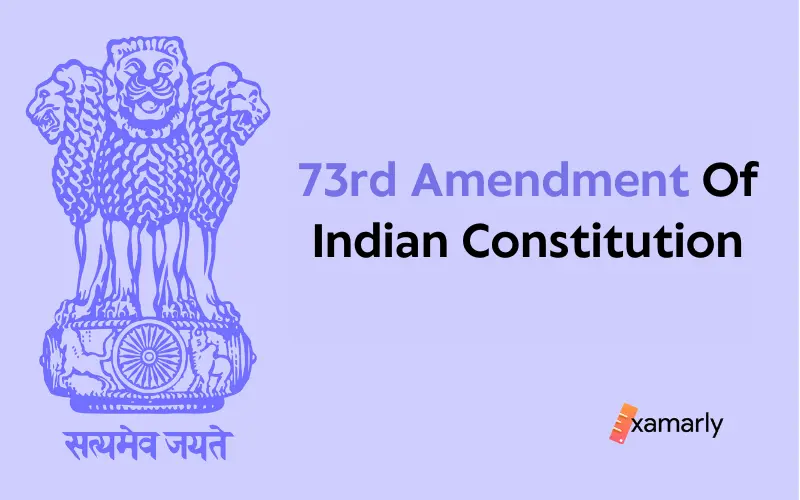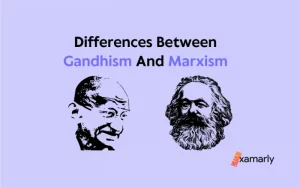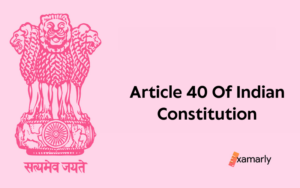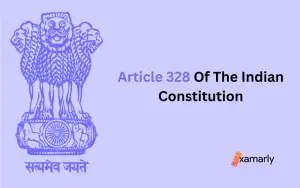By establishing Panchayati Raj in India and constitutionalizing local governance through its foundation, the 73rd Amendment of Indian Constitution changed representational democracy into a participatory one and gave actual embodiment to the Directive Principles of State Policy.
In this article, we will learn what changes were brought by the 73rd constitution amendment and its effect on Indian Citizens. This article will be beneficial for the candidates preparing for UPSC Exam, as it is a part of the UPSC Syllabus.
- What Is The 73rd Amendment Of Indian Constitution?
- The Advancement Of Panchayati Raj
- Objectives And Reasons
- Key Points
- Importance Of The 73rd Amendment
- Significant Features
- Gram Sabha
- Three-Tier System
- Accounts Audit
- Request For Union Territories
- Seat Reservations
- Electoral State Commission
- Timeframe Of A Panchayat
- Member And Chairperson Elections
- Duties And Power Of The Panchayats
- Finance Commission
- Finances
- Bar To Interference By Courts In Electoral Matters
- 73rd Amendment Act 1992 – Compulsory And Voluntary Provisions
- Eleventh Schedule
- The Three-Tier Structure of Panchayats in India
- Gram Panchayat
- Panchayat Samiti
- Zila Parishad
- The 73rd Amendment's Impact
- Issues In The Implementation
- Conclusion
- FAQs On 73rd Amendment Of Indian Constitution
What Is The 73rd Amendment Of Indian Constitution?
The Seventy-Third Amendment Act of 1992 was a significant reform in the Constitution of India. It introduced the concept of gram panchayats, which is a third-level government that deals directly with the public and works to address problems at the grass-roots level. Article 243 (b) defines the gram sabha, which consists of persons registered on the electoral rolls. It is the basic unit of the Panchayati Raj Institution. This institution is empowered to perform various functions at the village level, including establishing schools and health facilities.
This act granted constitutional status to panchayats and democratized decentralization. It also empowered panchayats at all levels to levy taxes and collect duties. It further ensures that people at the grassroots level are more engaged in the governance process.
The 73rd Amendment of Constitution of India focused on improving rural political structures and the rights of vulnerable populations. The Act emphasized the need for women to be a part of local government structures. This law made it simpler for women to get involved in politics by giving them greater possibilities. The act also made women eligible to serve as Panchayat members.
The 73rd amendment Act of Indian Constitution also made provisions for reserving seats for SC/ST/OBC communities and women in the legislature. In addition, it removed the upper population limit in parliamentary constituencies.
The Advancement Of Panchayati Raj
India’s evolution towards decentralization was a key driver for the Panchayati Raj System. Its implementation was made possible by passing the Panchayati Raj Act in 1992. The Act created Zilla Parishad, or village councils, which had the power to run local affairs.
Balwant Rai Mehta Committee (1957): The Panchayati Raj, or “democratic decentralization,” program was first proposed by the Balwant Rai Mehta Committee. The year 1957 saw this. The committee offered several important suggestions, including the following:
- The creation of a three-tier system of Panchayati raj.
- Directly elected representatives should make up the village panchayats.
- They ought to be in control of planning and development.
- Transferring adequate resources to these entities is necessary.
- To effectuate the delegation of powers, a suitable system must be implemented.
Ashok Mehta Committee (1977): The Janata government commissioned the Ashok Mehta Committee to offer suggestions for cementing and reviving these deteriorating institutions. It made several essential suggestions, including:
- A two-tier system ought to take the place of the three-tier system.
- Decentralization should start at the district level.
- ZP ought to be the governing body.
- The political parties ought to participate formally.
- They should be given mandatory taxing authority.
- An ongoing social audit.
- If Panchayati bodies are supplanted, elections must be held within six months.
- At the state level, a Panchayati raj minister should be chosen.
- Seats are reserved for SC and ST.
- These institutions should have constitutional recognition.
- Seventy-third Constitutional Amendment Act 1992, objectives
Objectives And Reasons
Even though the Panchayati Raj Institutions have been around for a while, it has been noted that they have not been able to achieve the status and dignity of viable and responsive people’s bodies for several reasons, including the lack of regular elections, prolonged supersessions, inadequate representation of weaker groups like women and SC and ST, inadequate devolution of power, and a lack of financial resources.
Article 40 of the Constitution of India, which preserves one of the Directive Principles of State Policy, states that the State should make efforts to organize village panchayats and grant them the essential authorities and authority to act as self-governing bodies. In light of the last forty years of experience and the shortcomings that have been identified, it was determined that there was an urgent need to enshrine in the Constitution certain basic and essential features of Panchayati Raj Institutions in order to provide certainty, continuity, and strength to them.
Therefore, It was proposed that a new part relating to the panchayat be added to the constitution of India. And to provide the following, among other things:
- Setting the duration of Panchayats at 5 years and holding elections within 6 months after any Panchayat’s supersession.
- Direct elections are held for all Panchayat members at the village and intermediate levels, as well as Panchayat Chairperson posts at these levels.
- Panchayats are formed at the village and other levels.
- Reservation of not less than one-third of total seats for women and quota of seats for SC and ST in line with population for Panchayat membership and office of Chairpersons in Panchayats at each level
- Disqualifications for membership of Panchayats.
- Establishment of a Finance Commission within one year after the proposed change, and then every five years, to assess the financial health of Panchayats.
- Devolution of authorities and duties to Panchayats by the State Legislature in the drafting of plans for economic growth and social justice, as well as the execution of development projects.
- Direction and control of the State Chief Electoral Officer
- Auditing of Panchayat accounts, the authority of state legislatures to set provisions for Panchayat elections under superintendence.
- Existing laws and Panchayats would be maintained until one year after the proposed change takes effect, and courts will be barred from interfering in Panchayat electoral procedures.
- Applicability of the provisions of the aforementioned Part to Union territory, with some States and regions exempted from such application.
The Bill sought to attain the objectives above.
Key Points
- The 73rd Amendment Act of 1992 gave local governments constitutional status. It came into effect on 24th April 1993.
- The constitution gained the 11th schedule, which listed 29 Panchayat-related topics.
- Additionally, Part IX, which included provisions from Articles 243 to 243 O, was introduced to the Constitution by this measure.
- With this modification, the state governments were now required by the constitution to enact the new Panchayati Raj system by its guidelines.
Importance Of The 73rd Amendment
This amendment carries out Article 40 of the DPSP, which mandates that governments must take measures to create village panchayats and give them the essential authorities and authority to function as self-government entities. This amendment has upgraded village panchayats from an unjustifiable to a justifiable part of the constitution and has given states a constitutional obligation to enact Panchayati raj acts by Part IX’s requirements. However, states have been granted ample latitude to embrace the Panchayati Raj System while considering their unique geographic, politico-administrative, and other circumstances.
Significant Features
The 73rd Amendment of Indian Constitution was passed by both houses, i.e., the lower and upper houses of the Parliament of India, and came into force on 24th April 1993. It strengthened local self-government in India and made Panchayati Raj institutions constitutional bodies. The act provides that state governments must form panchayats in their jurisdictions and devolve their powers. It also fixes the tenure of gram panchayats at five years.
Gram Sabha
Article 243(b) defines Gram Sabha, which states that a gram sabha is a body made up of people who are enrolled on the electoral rolls for the village that falls under the jurisdiction of the Panchayat at the village level. It is the Panchayati Raj Institution’s foundation. Article 243A of the Indian Constitution authorizes the Gram Sabha to fulfill the tasks given by law or the State Legislature at the village level.
Three-Tier System
Article 243B of the Indian Constitution mandates that panchayats be formed at the village, intermediate, and district levels in each state, in the Panchayati Raj Institutions.
Accounts Audit
The State Legislature is empowered under Article 243J to provide arrangements for panchayats to keep and audit their accounts.
Request For Union Territories
The provisions of this Part cover the territories of the Union. The president, however, has the authority to identify and order any necessary exceptions or modifications.
Seat Reservations
Article 243D allows for the provision of seat reservation, which defines the allocation of seats for SCs and STs based on their demographic share. The Article further states that one-third of all seats must be allocated for women who are members of the SCs or STs. This Article authorizes the State Legislature to enact any measure pertaining to backward class reserve.
Electoral State Commission
The state election commission has been established and given several responsibilities. These responsibilities include oversight, direction, and control over the creation of electoral rolls. The state electoral commission is also responsible for managing the Panchayat elections.
Timeframe Of A Panchayat
Article 243E provides that panchayats have a 5-year tenure if they are not dissolved before the end of their term. If the panchayat is dissolved, the other panchayat that was formed will continue to function for the remaining time that the dissolved Panchayat would have lasted.
Member And Chairperson Elections
The chairperson of the Panchayat shall be indirectly elected from among the elected members at the intermediary or District level. At the same time, the members of the Panchayat at the village, intermediate, and district levels shall be directly elected by the people.
Duties And Power Of The Panchayats
Article 243G requires the State Legislature to pass legislation granting panchayats the necessary ability and authority to act as a unit of self-government. The panchayats are responsible for developing a strategy for economic growth and social justice for the people. The Article empowers the state government to delegate authority and power to panchayats on all of the 29 subjects prescribed in the Eleventh Schedule for local planning and implementation of schemes, such as the Mahatma Gandhi National Rural Employment Guarantee, 2006, MGNREGA, which is one of the largest employment-generating schemes. Panchayats carry out national and state government programs to improve people’s lives on the ground. Gram Panchayat has the ability to expand employment opportunities and focus on community development.
Finance Commission
The Constitutional (Seventy-Third Amendment) Act 1992 significantly changes the Indian constitution. This Act provides legal support for local panchayats and enables them to exercise more control over their affairs. However, it also introduces several limitations. Part IX of the amendment does not apply to tribal and Scheduled Areas. However, parliament has the power to make a law that extends Part IX to these areas.
In addition to providing for local self-government, the legislation authorizes the state legislature to form a finance committee to examine panchayat finances and suggest tax allocation between the state and panchayats. The taxes, duties, and tolls are to be collected by panchayats. These also get determined by the finance commission. State legislatures can also endow panchayats with powers to ensure economic development and social justice.
Finances
Powers to impose taxes by, and Funds of, the Panchayats:
- A panchayat may be given permission by the state legislature to charge and collect taxes, duties, and fees;
- The state legislature may delegate to the panchayat taxes, duties, and fees imposed and collected by the state government;
- The state legislature may give grants-in-aid to the panchayats from the state’s consolidated fund;
- The state legislature may establish funds to which all money belonging to the panchayats may be credited.
Bar To Interference By Courts In Electoral Matters
The 73rd Constitutional Amendment Act of 1992 prohibits judges from interfering with local elections. This act also bars courts from challenging laws about the delineation of constituencies and allotment of seats. The only way to contest an election is through an election petition, which must be presented in the manner provided by the state legislature.
The Constitution of India governs the Bar to Interference by Courts in a Panchayat election. The law provides that a candidate must be at least 21 years old to contest the election. A Panchayat has a five-year term and the State Finance Commission reviews its financial situation.
Relatable Article:
States And Regions Exempted
The statute does not apply in Nagaland, Meghalaya, or Mizoram, as well as a few other states in India. These areas include scheduled and tribal territories inside the states of India. The district council-governed hill regions of Manipur and the Darjeeling district of West Bengal.
However, the requirements of this Part may be extended to scheduled areas and tribal territories, subject to the exclusions and changes prescribed by the Parliament of India.
Under this clause, the Panchayats Extension to Scheduled Areas Act, popularly known as the PESA Act or the Extension Act, was passed by Parliament in 1996.
73rd Amendment Act 1992 – Compulsory And Voluntary Provisions
The 73rd amendment of the Indian constitution deals with the devolution of certain powers to Panchayats. Although some provisions of the act are compulsory, others are voluntary, allowing state governments to consider local factors. In this way, the CAA facilitates the development of grassroots democracy.
Compulsory Provisions
- Setting up the State Election commission for the duration of five years, to conduct elections of Panchayati Raj Institutions.
- In villages, constituting gram Sabha.
- Establishing a three-tier system, village, intermediate, and district level.
- Reservation of seats for SC and ST depending upon the population and also reserving seats for women in one-third of total seats.
- Direct elections for all members of the panchayat and indirect elections for the chairman at the intermediate and district level.
Voluntary Provisions
- Providing MPs and MLAs with representation in Panchayats at various levels.
- Reservation for the lower classes.
- Giving panchayats financial authority.
- Giving panchayats permission to act as self-governing units.
Eleventh Schedule
Panchayats are given jurisdiction over the following 29 essential items:
- Minor irrigation, watershed development, and water management.
- Land enhancement, land reform implementation, soil conservation, and land consolidation.
- Agriculture, including agricultural extension
- farm forestry and Social forestry
- Fisheries
- dairying, Animal husbandry, and poultry
- village, Khadi, and cottage industries
- Small-scale industries, including food processing industries
- Minor forest produce
- Fuel and fodder
- Drinking water
- Technical training and vocational education
- Rural housing
- Non-conventional energy sources
- Rural electrification, including the distribution of electricity
- Roads, culverts, bridges, ferries, waterways, and other means of communication
- Poverty alleviation program
- Women and child development
- Libraries
- Adult and non-formal education
- Education, including primary and secondary schools
- Cultural activities
- Family Welfare
- Health and sanitation, including hospitals, primary health centers, and dispensaries
- Social welfare includes disabled and mentally disabled people’s welfare
- Markets and fairs
- Maintenance of community assets
- Public distribution system
- The well-being of the lower groups, particularly the SCs and STs.
The Three-Tier Structure of Panchayats in India
73rd amendment of the Indian constitution is related to the introduction of the Panchayati Raj Institution. PRI has the three tier Structure, namely:
- Gram Panchayat at the Village level.
- Panchayat Samiti at the block level.
- Zila Parishad at the District Level.
Gram Panchayat
Gram panchayats are responsible for cleanliness, cleaning public roads, and public toilets, and providing safe drinking water, primary healthcare, and education. For example, for the benefit of the villages, programs such as the Jal Jeevan Mission and Pradhan Mantri Awas Yojna are being implemented. Jal Jeevan Mission is an initiative that aims to supply functioning water faucets in all homes. The Pradhan Mantri Awas Yojna is an initiative that seeks to give housing to all households living below the poverty line (BPL).
Panchayat Samiti
Panchayat Samiti is the Panchayati system’s second layer, connecting the gram panchayat to the Zila Parishad. Panchayat Samiti members are chosen directly. Gram Panchayat Sarpanches are ex-officio members of Panchayat Samiti.
Zila Parishad
It is the highest layer of the system, with members directly chosen by the people. The Chairperson of Panchayat Samiti is chosen as an ex-officio member of Zila Parishad, while members of district parliaments, legislative assemblies, and councils are nominated as members of Zila Parishad.
The 73rd Amendment’s Impact
- Local self-government in the nation has significantly improved as a result of the 73rd Amendment’s passage.
- The central government chose to recognize April 24 as National Panchayati Raj Day. Every year to commemorate this and further bolster the institutions.
- The formalized Panchayati raj operates today on three levels i.e.,
- The Gram Panchayat (at the village level),
- The Mandal Parishad/Panchayat Samiti/Block Samiti (at the block level),
- and the Zila Parishad (District Level)
Issues In The Implementation
- The most serious issue in the 73rd Amendment Act of Indian Constitution was the lack of financing for PRIs, which forced local governments to rely on local taxes or intergovernmental transfers to pay for their operations.
- The Amendment Act grants PRIs constitutional legitimacy, but it allows the state government the authority to transfer functions, duties, and funds to panchayats.
- The inclusion of PanchPati and proxy representation of women, SCs, and STs dilutes the goal of seat reservation for women, SCs, and STs.
- The involvement of MPs and MLAs in PRI operations reduces their effectiveness.
- There are fundamental faults in the PRI system, such as a lack of secretarial assistance and technical expertise.
Conclusion
The 73rd Constitutional Amendment Act 1992 brought constitutional sanction to the Panchayati Raj system in India. The act introduced Part IX of the Constitution of India, which contained 29 subject matters related to gram panchayat. This amendment provided legal backing for gram panchayat and strengthened their power and autonomy.
FAQs On 73rd Amendment Of Indian Constitution
Why Did The Government Propose The 73rd Amendment Act Of Indian Constitution?
The government of India proposed the 73rd Amendment of Indian Constitution because, though the PRI has been around for a while, it has been noted that they have not been able to achieve the dignity and status of viable and responsive people’s bodies for a number of reasons, including the lack of regular elections, protracted supersessions, inadequate representation of weaker groups like women and SC and ST, inadequate devolution of power, and a lack of financial resources. In order to provide certainty, continuity, and strength to Panchayati Raj Institutions, in view of shortcomings that have been observed in the last forty years. It was proposed that a new part relating to the Panchayati raj be added to the constitution of India






